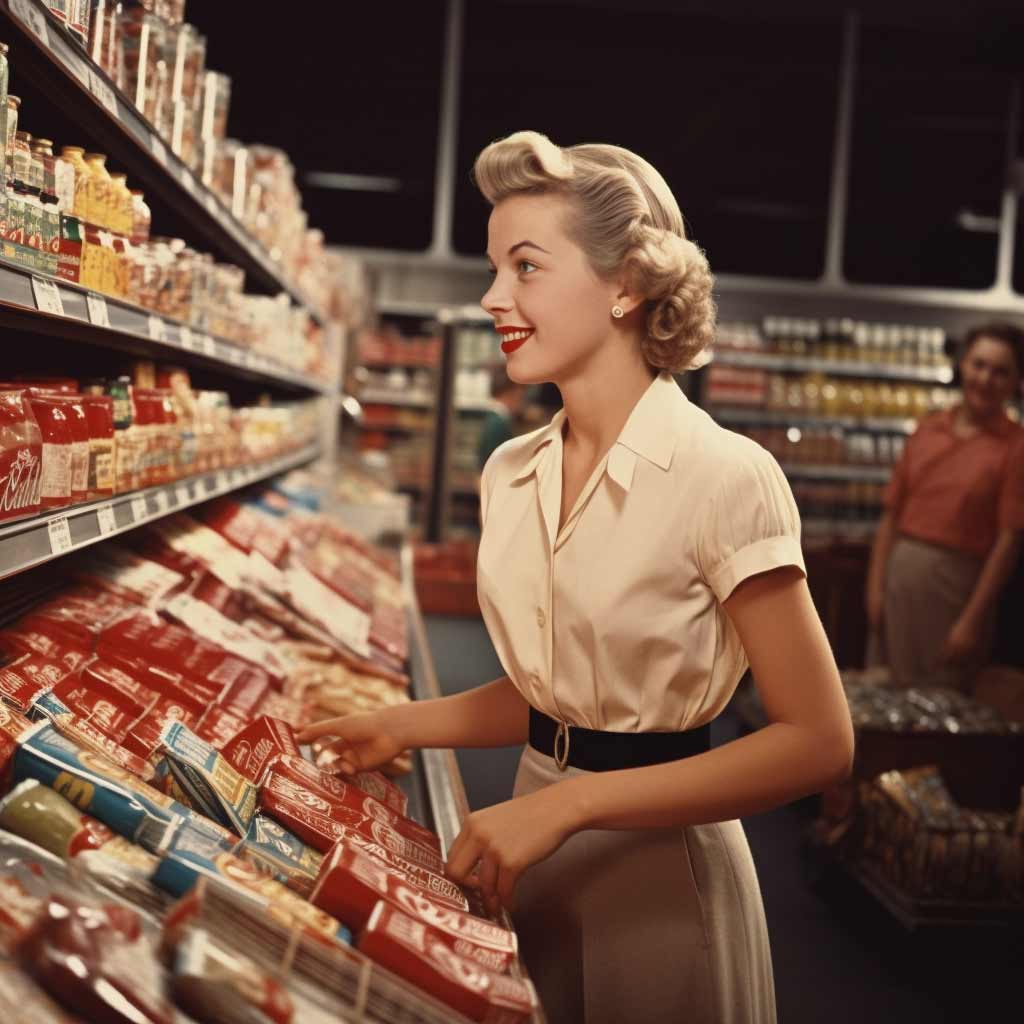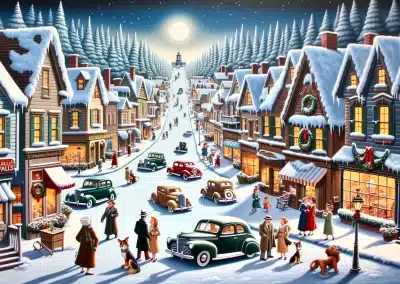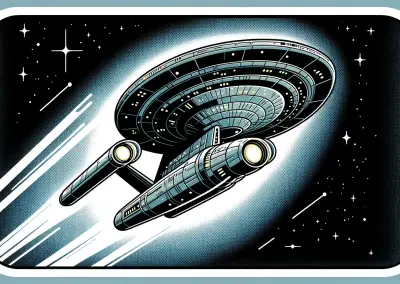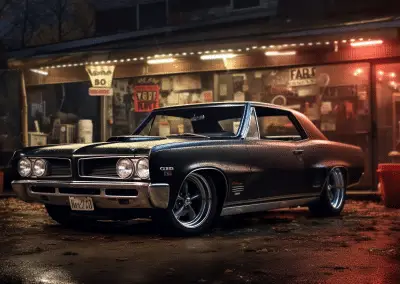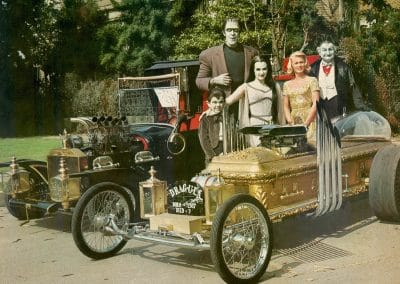Grocery shopping in the 1950s was a vastly different experience than what we have today. The atmosphere, the selection of products, and the overall shopping experience all had a unique charm that can still evoke a sense of nostalgia. As I think back on those days, I can’t help but remember the sights, sounds, and even the aromas that filled the air as I walked the aisles with my family.
The grocery stores of the 1950s were smaller than today’s supermarket giants, but they were far from lacking variety. Shelves were stocked with popular products and brands, many of which live on to this very day. Yet, there was something undeniably charming about the personal touch offered by store employees, who were always eager to assist you in finding your desired items. Shopping might have been a more time-consuming affair, but it was certainly a more intimate and communal experience.
Key Takeaways
- Grocery shopping in the 1950s had a unique charm and more intimate, communal experience
- The stores were smaller but offered a diverse selection of popular products and brands
- Nostalgia for this era persists, informing modern adaptations and exhibits
Grocery Stores of the 1950s
Piggly Wiggly
I remember the first time I walked into a Piggly Wiggly in the 1950s, and it was like entering a new world. The self-service concept had taken off, and customers were taking their grocery carts and browsing through the aisles themselves. The shelves were stocked with a variety of products, and I could see why Piggly Wiggly was called the “innovator of the supermarket.”
The Piggly Wiggly was the epitome of grocery shopping back in those days, providing convenience and variety at its best. They offered fresh produce, quality meats, and an array of packaged goods – all at reasonable prices. Plus, the staff was always helpful and responsive whenever I had questions or needed assistance.
Kroger
Kroger was another popular grocery store that I frequented in the 1950s, with its wide variety of products and outstanding customer service. When I entered the store, I was always greeted warmly by the employees, who were eager to help me find what I was looking for.
At Kroger, I found their house brand products to be of great quality, which made shopping there an even more economical choice. Additionally, they were ahead of their time, with innovations like self-checkout for faster customer service.
In the 1950s, there were many other grocery stores like A&P, Food Fair, and Red Owl, which were quite popular in their regions. However, Piggly Wiggly and Kroger stood out to me as the leaders in the grocery shopping experience.
One day, when I was outside of the city, I had a chance to visit a small general store. It was a completely different experience from my usual shopping trips to the larger grocery stores. The general store had a cozy feel, and it took me back in time with its old-fashioned cash register, wooden floors, and friendly workers. It stocked a limited selection of products, but had that unique charm that the bigger grocery stores simply couldn’t replicate.
Shopping Experience
Shopping Carts
I remember walking into the store and grabbing a shopping cart. Back then, they were smaller than the ones we have today, but they served their purpose. The metal carts were lined up for us to pick, but we had to be careful of squeaky wheels. Sometimes a wobbly one would slow us down!
Milk and Produce Department
In the milk and produce department, everything was so much fresher. The shelves were stocked with glass bottles of milk delivered by the local dairy farm, and the produce just seemed to taste better. We had to pick our fruits and vegetables with care, taking our time to make sure nothing was bruised.
Frozen Foods Section
The frozen foods section was always fascinating. The refrigerator cases hummed with cold air, reminding me of a chilly winter day. Picking out my favorite ice cream flavor was definitely a highlight of my shopping trips. The TV dinners arranged in colorful boxes, however, were more of a novelty back then.
Cash Registers and Checkout Lanes
Finally, at the cash registers and checkout lanes, it’s amazing to think that we didn’t have conveyor belts or scanning systems. Items were placed individually on the counter, and the cashier swiftly typed in each price on the mechanical cash register, often without looking. The cashier handed us our change and receipt, and we’d carefully pack our groceries into sturdy paper bags.
To me, those memories are still vivid, and the experience of grocery shopping in the 1950s seems much more personal than it is today. We really took our time to explore the store, chat with the workers, and make well-considered decisions about our purchases. It was a simpler time, and one that I cherish as part of my life story.
Popular Products and Brands
Collections of the 1950s
I remember grocery shopping in the 1950s was a delightful experience with lots of popular products and brands lining the shelves. It was always a treat to walk down the aisles and discover new products or find old favorites.
One of my favorite candies back then was candy bars. I loved the variety of flavors and the fun packaging. Some popular candies during that time were Mars bars, Snickers, and Milky Way. The brightly colored wrappers and catchy names were hard to resist. It was always a special treat when I got to pick out a candy bar to enjoy.
Another notable brand during the 1950s was Pepperidge Farm. I fondly recall their delicious bread, cookies, and crackers. Their distinctive packaging stood out on the store shelves, with the famous red oval logo and intricate illustrations. The Milano and Geneva cookies were my favorites, featuring rich, delicate flavors and sandwich-style cookies that melted in your mouth.
In addition to candy and Pepperidge Farm products, the 1950s grocery stores were filled with iconic products and brands such as:
- Breakfast cereals: Kellogg’s Corn Flakes, Frosted Flakes, and Rice Krispies were all popular choices for a morning meal.
- Canned goods: Campbell’s Soups, Del Monte fruits and vegetables, and Chef Boyardee pasta were pantry staples.
- Packaged foods: Jell-O desserts, Kraft Macaroni & Cheese, and Birds Eye frozen vegetables made meal prep simple and convenient.
Grocery shopping in the 1950s was a nostalgic experience, filled with popular products and brands that are still beloved today. From candy bars to Pepperidge Farm treats, these items filled the shelves and made shopping a delightful adventure.
Supermarkets Evolution
When I think back to grocery shopping in the 1950s, I can see how supermarkets have evolved over the years. The 1960s and 1970s brought about some significant changes in the supermarket industry, and I’d like to share with you how that took place.
Target and Walmart
The 1960s saw the birth of two major retail giants, Target and Walmart. Both stores began as discount department stores, with the goal of selling a wide range of products at low prices. As they expanded, they eventually began incorporating grocery items into their offerings.
This changed the game for supermarkets as people were able to purchase both general merchandise and groceries in one location. The stores soon began to be called “supercenters,” making shopping more convenient and efficient for customers. This concept became increasingly popular and played a significant role in shaping the supermarket landscape.
Aldi and Wegman’s
These stores also made significant contributions to the supermarket evolution, although in different ways. Aldi first opened its doors in the 1960s, offering a no-frills, low-priced shopping experience. Their focus was on offering a limited assortment of high-quality, private-label products, cutting costs in other areas like store décor or advertising.
While Aldi focused on low-cost simplicity, Wegman’s provided a far more extensive and upscale shopping experience. Established in 1916, Wegman’s emphasized variety, offering a wide range of products. By the 1960s and 1970s, they had become well-known for their incredible selection, including a fantastic array of fresh produce, meats, cheeses, and baked goods.
In the end, both Aldi and Wegman’s played important roles in shaping the contemporary supermarket experience, offering different options for various consumers with distinct needs and preferences.
Looking back at the vintage 1960s supermarkets, it is fascinating to see how much has changed, from the store designs and layouts to the assortment of products available. We can appreciate the journey supermarkets have taken and enjoy the convenience and variety they provide today.
Modern Adaptations
Displays and Store Layouts
As I think back to grocery shopping in the 1950s, I can’t help but notice the many changes that have taken place in the world of retail since then. The modern adaptations of displays and store layouts seem to have been influenced greatly by the past.
Back in the day, shopping carts were a rare sight, often made of metal and large enough to accommodate only a few items. Today, shopping carts have evolved into lightweight, plastic designs that can carry an entire week’s worth of groceries. They’ve even added cup holders for added convenience.
In the 1950s, checkout counters featured human cashiers who handled both the groceries and money transactions. Alongside them were paper bags, which were the main means of carrying groceries home. Fast forward to the present, and you’ll see automated self-checkout machines alongside cashiers. As for grocery bags, the plastic bag has become a standard, though many people now opt for reusable bags in an effort to be more environmentally friendly.
The store layout back in the 1950s was simple and straightforward, with shelves arranged in rows and customers guided by signs indicating the types of products available in each aisle. It was easy to find what you needed, and the whole shopping experience had a cozy, neighborhood feel.
These days, modern store layouts focus on efficiency and creating an inviting atmosphere. Products are organized in a more strategic manner, with promotional displays and eye-catching arrangements. Technology has also made its way into the shopping experience with digital signs, touchscreens, and even grocery-delivery services.
Despite the passage of time and all the modifications, the core elements of grocery shopping remain the same. We still need carts to carry our items, check out to make our purchases, and bags to bring home our groceries. It is fascinating to see how these aspects have adapted over the years and to consider what other developments we may see in the future.
Nostalgia and Exhibits
I recently visited a museum that had an exhibit on old-fashioned grocery stores from the 1950s, and it took me right back to my childhood memories. The exhibit showcased a replica of a typical 1950s grocery store with authentic products and packaging, which was a fantastic walk down memory lane.
As I walked through the exhibit, I noticed the simplicity and colorful design of product packaging. It was a drastic difference compared to the flashy, attention-grabbing packaging of today. Everything felt familiar, from the vintage signs to the manual cash register. Even the smell of the store was something I hadn’t experienced in years.
In the 1950s, grocery shopping was much more of a personal experience. As I reminisced, I remembered how the store clerks knew my name and greeted me with a smile. They were always ready to help carry heavy bags or find specific items. My favorite part of the whole experience was interacting with the store owners, who became close family friends over the years.
I also noticed the absence of self-checkout counters and conveyor belts, a reminder of the days when shopping was a more intimate and relaxed affair. Instead, there were simple wooden counters, with customers placing their items on them while the cashier tallied the total manually. The absence of computers and electronic devices was refreshing.
I couldn’t help but compare the exhibit’s atmosphere to modern grocery stores. While our current technology and variety of products provide many conveniences, there was a certain charm and personal touch to the grocery shopping experience in the 1950s that’s been lost over time.
If you ever have a chance to visit a museum with an exhibit like this, I highly recommend it. You’ll be transported back in time and experience the nostalgic warmth of old-fashioned grocery stores from the 1950s.
Frequently Asked Questions
What were popular grocery stores in the 1950s?
In the 1950s, several popular grocery stores were operating, including A&P, Safeway, Kroger, and Piggly Wiggly. These chains were household favorites, and many families went to those stores to make their weekly purchases.
How has grocery shopping changed since the 1950s?
The grocery shopping experience has changed quite a bit since the 1950s. In those days, I remember clerks would help shoppers, often hand-picking items for them. Self-service was uncommon, and so were plastic bags. Today, grocery shopping is significantly more efficient. We have barcodes, self-checkout stations, automatic doors, and various technological advancements that streamline the process.
What products were commonly found in 1950s grocery stores?
When I visited 1950s grocery stores, I would typically find products like canned goods, fresh produce, meats, and dairy. The variety of packaged foods was limited compared to today. Notably, frozen foods like TV dinners were just starting to become popular. Processed foods were less prevalent, and people favored more homemade meals.
What was the shopping experience like in the 1950s?
Grocery shopping in the 1950s was quite different from what we see today. The store itself was smaller, offering a more intimate atmosphere. The aisles were narrow, and the lighting wasn’t as bright. Most stores used paper bags, and customers were expected to bring a shopping list. The concept of loyalty cards and targeted marketing was nonexistent.
Which 1950s grocery stores went out of business?
While some grocery chains remain, others have gone out of business or changed considerably over the years. A&P was a popular store in the 1950s, but filed for bankruptcy multiple times before disappearing altogether. Other stores, like Piggly Wiggly and Kroger, still exist but have been rebranded or altered throughout the years.
What were popular department stores in the 1950s?
In the 1950s, several department stores were quite popular, including Sears, Roebuck and Co., J.C. Penney, Montgomery Ward, and Woolworth’s. These stores often featured budget-friendly, mass-produced products, fashion, and home goods. At the time, many people visited these stores frequently, and they played a significant role in the era’s shopping culture.

